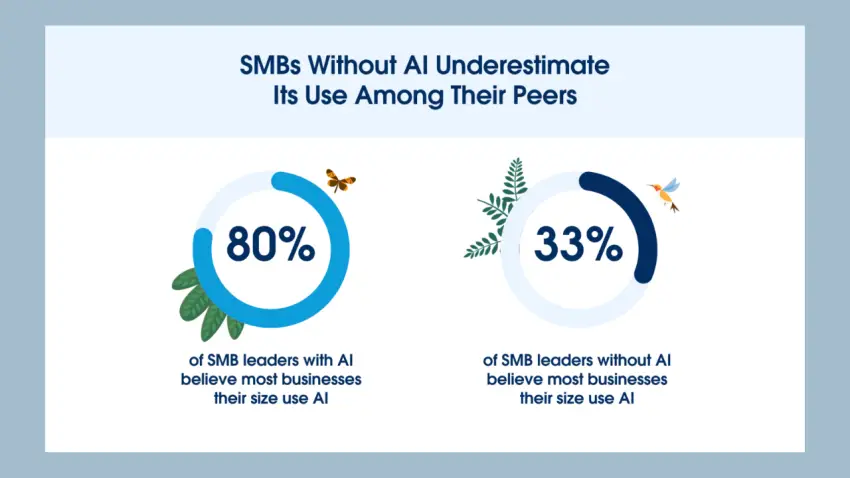
Data Is the New Oil: Building Your AI-Ready CRM Foundation
Data has been compared to oil for a reason: it powers modern innovation. Small and medium-sized businesses (SMBs) that embrace AI are seeing real results—91 % of AI-enabled SMBs report increased revenue, and these gains are tied directly to data quality. Growing SMBs recognize this reality: 74 % are prioritizing data-management investments and 66 % are adopting integrated tech stacks to eliminate data silos. At the same time, more than three-quarters of small businesses have already adopted AI in some capacity, and 87 % report increased productivity. The takeaway is clear: a solid, unified data foundation is the fuel that helps AI turn leads into bookings and bookings into long-term relationships.

The rising cost of bad data
Running a home-service business without a central CRM is like trying to navigate Atlanta traffic blindfolded. Siloed call logs, scattered email lists and disparate payment systems prevent AI tools from generating insights. They also make follow-up tasks prone to human error. Research from Salesforce shows that growing SMBs are more than 80 % more likely to adopt AI than declining competitors. They’re doing so because integrated systems create a single source of truth about customers: call recordings, SMS conversations, email threads, payment histories and service notes live in one place. When data is unified, AI can spot patterns, score leads and personalize outreach that drives revenue growth.
Poor data isn’t just inefficient; it’s expensive. Bluevine’s 2025 small-business survey found that inflation (71.4 %) and rising operational costs (62.4 %) top owners’ concerns, whereas only 24.4 % worry about technological risks like cybersecurity and AI. Yet, security still matters: 23.3 % cite data-security vulnerabilities as their biggest barrier to adopting AI for financial operations, and 16.6 % worry about accuracy and reliability. When customer records live across multiple spreadsheets, it becomes difficult to secure or validate them. Bad addresses lead to missed appointments. Duplicate entries waste marketing dollars. In the worst-case scenario, data breaches expose private customer details and erode trust.

Data quality is the foundation of AI success
AI tools are only as intelligent as the data they ingest. According to Small Business Trends, AI-enabled SMBs experience increased earnings across operations and improved efficiency when they prioritize data quality. Conversely, companies with messy data struggle to see value from AI. That is why cleaning and integrating information should be the first step in any AI initiative:
Audit existing data. Begin by locating every touchpoint: call logs, SMS histories, email campaigns, invoice records and review sites. Use deduplication to remove duplicates, correct misspellings and standardize formats. Many AI-powered deduplication tools can flag mismatched contacts automatically.
Integrate disparate systems. Replace multiple spreadsheets and standalone tools with a unified CRM. PulseCRM, for example, centralizes calls, SMS, emails and payments, providing a single dashboard for your team. A unified system makes it possible to assign unique identifiers to each customer and track their lifecycle seamlessly.
Normalize fields. A phone number can appear in ten different formats depending on the form used. Standardize date fields, addresses and phone numbers so AI models see consistent patterns. This is essential for accurate lead scoring and segmentation.
Segment and score leads. Once data is clean, use AI to segment customers by behaviour and value. AI models can assign scores based on call frequency, service history and purchase size, ensuring follow-ups are targeted and timely.
Implement voice AI to capture unstructured data. Many home-service businesses still rely on handwritten notes after a call. Voice AI transcribes calls, tags intent (e.g., service request, complaint, scheduling) and updates records automatically. This not only reduces manual data entry but also captures nuance that might otherwise be lost.
Why on-device AI matters for privacy and latency
Trust is a top barrier to AI adoption. Customers don’t want their conversations shipped off to distant servers, and owners don’t want to risk fines over privacy violations. Local or on-device AI solves these problems by processing information right on your device instead of in the cloud. According to ObjectBox, local AI keeps data on the device and under the user’s control, delivering the benefits of privacy and data security. It also reduces latency by minimizing data transmission, enabling real-time response and lower cloud costs. The 5G Americas association similarly notes that on-device processing reduces the need to send data to the cloud, minimizing network traffic. For home-service businesses, this means a voice assistant can answer calls, schedule appointments and take payments without sending sensitive audio across the internet. Clients appreciate the speed and confidentiality, and owners reduce risk.
Building your AI-ready CRM foundation: A practical framework
Run a data-health check. Use automated tools to scan for duplicates, incomplete records or conflicting information. Establish metrics such as percentage of complete profiles and frequency of data entry errors. Aim for at least 90 % completeness before layering AI.
Create a single customer view. Consolidate call logs, emails, SMS, social media messages and payments into one timeline per customer. This eliminates guesswork about where a client stands in the service journey and allows AI to derive insights.
Adopt secure local AI. Use on-device models for tasks like call summarization, voice-assistant responses and payment handling. This ensures sensitive data remains within your system while still benefiting from AI capabilities.
Automate basic interactions. Deploy chatbots and voice bots to handle common questions, schedule appointments and send reminders. AI chatbots can handle up to 70 % of customer interactionsand free your team for more nuanced conversations.
Leverage analytics for continuous improvement. Track metrics such as call conversion rates, average response time and repeat booking rates. Compare results before and after implementing AI to quantify its impact. According to Bluevine, 58 % of users save more than 20 hours per month and 66 % save $500–$2 000 monthly by using AI. Reinvest those savings in marketing and training to accelerate growth.
Siloed vs. integrated: A mini case
Imagine two Atlanta cleaning companies. The first uses separate spreadsheets for prospects, invoices and service notes; the second uses PulseCRM to centralize everything. Both run Facebook ads that generate 100 leads. The first company’s assistant manually copies call information into a spreadsheet, often missing digits and forgetting to tag service type. Follow-up emails go to the wrong addresses; duplicate contacts clutter the list; and only 15 customers book. The second company’s voice AI answers calls, transcribes details, tags service type and creates a unified customer profile. The marketing module then sends personalized texts and emails at optimal times. Because the data is clean and integrated, 35 leads convert. In this simplified example, an integrated CRM yields more than double the bookings without extra advertising spend.

Addressing data privacy concerns
Even though inflation and costs dominate small-business worries, 24.4 % of owners still see security as a significant barrier and 16.6 % worry about accuracy. Transparency is key. Tell clients that their calls are being handled by a voice assistant but that all processing is done on secure, local servers. Ask for consent to store their information and explain how it improves service (e.g., faster scheduling, personalized follow-ups). Use encryption at rest and in transit, implement role-based access controls and ensure vendors follow industry standards like GDPR and HIPAA. This builds confidence and increases adoption.
Continuous improvement & data governance
Cleaning your data once is not enough; it’s an ongoing discipline. Establish data-governance policies to ensure consistency as your company grows. Assign data stewards to monitor quality metrics and set up automated alerts when anomalies occur—such as sudden spikes in duplicate entries or incomplete profiles. Schedule regular “data health days” where your team reviews and updates records. Encourage technicians and front-line staff to input information accurately, and provide training on why proper data entry matters for AI performance. As new tools come online, assess their data-handling practices to ensure they align with your governance standards. Continual improvement prevents the gradual decay of your CRM and keeps your AI models performing at peak efficiency.
Data is no longer an afterthought—it’s the asset that fuels AI-driven growth. By cleaning and integrating your data, adopting privacy-preserving on-device AI and building workflows that span calls, emails, SMS and payments, you create a CRM foundation that converts leads into lifetime customers. With AI in place, you can spend less time chasing information and more time delivering exceptional service. Ready to see how clean data can unlock new bookings? Run a free data-health check and watch our on-demand webinar to discover how PulseCRM’s unified platform can prepare your business for the AI era.
